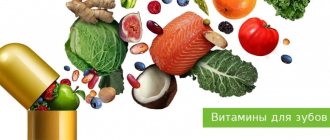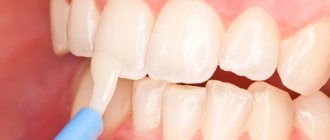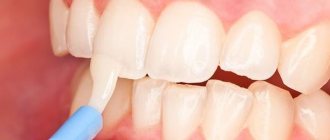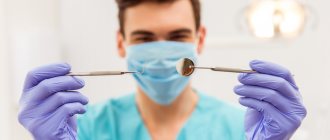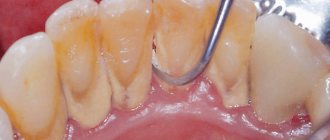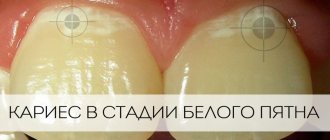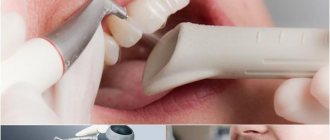Author of the article:
Soldatova Lyudmila Nikolaevna
Candidate of Medical Sciences, Professor of the Department of Clinical Dentistry of the St. Petersburg Medical and Social Institute, Chief Physician of the Alfa-Dent Dental Clinic, St. Petersburg
The human body is a kind of unified mechanism, the elements of which are closely interconnected. The health of all organs, including teeth, depends on the quality of products, the balance of the diet and, accordingly, the amount of nutrients received.
Everyone knows that calcium is necessary to strengthen teeth. But few people know about which foods this element is best absorbed from, what other vitamins and minerals they need, and what kind of nutrition can support dental health and good condition. Let's figure out what vitamins adults and children need to strengthen tooth enamel.
Alphabet Classic
Regular plaque removal at the dentist's office is important. Pathological deposits are easier and faster to remove in a soft state, without waiting for them to harden. This will prevent disease of the gum tissue and crowns.
A complex of three types of tablets: calcium, antioxidants, iron has a positive effect on the oral cavity. The tablets are taken daily, one from each group. The drug has a positive effect not only on the oral cavity, but on the entire body. Vitamin balance must be maintained at all times. The Alphabet includes 13 vitamins and 10 minerals.
Clinical researches
Clinical studies have proven that regular use of professional toothpaste ASEPTA REMINERALIZATION improved the condition of the enamel by 64% and reduced tooth sensitivity by 66% after just 4 weeks.
Sources:
- Report on the determination/confirmation of the preventive properties of personal oral hygiene products “ASEPTA PLUS” Remineralization doctor-researcher A.A. Leontyev, head Department of Preventive Dentistry, Doctor of Medical Sciences, Professor S.B. Ulitovsky First St. Petersburg State Medical University named after. acad. I.P. Pavlova, Department of Preventive Dentistry
- Clinical experience in using the Asepta series of products Fuchs Elena Ivanovna Assistant of the Department of Therapeutic and Pediatric Dentistry State Budgetary Educational Institution of Higher Professional Education Ryazan State Medical University named after Academician I.P. Pavlova of the Ministry of Health and Social Development of the Russian Federation (GBOU VPO RyazSMU Ministry of Health and Social Development of Russia)
- The use of new anti-inflammatory drugs in the complex of therapeutic and preventive measures for periodontal diseases (E.D. Kuchumova, A.A. Leontyev, O.V. Kalinina, L.Yu. Orekhova, S.B. Ulitovsky) E.D. Kuchumova, Ph.D., Associate Professor, A.A. Leontyev, dentist, O.V. Kalinina, dentist, L.Yu. Orekhova, Doctor of Medical Sciences, Professor, Head of Department, S.B. Ulitovsky, Doctor of Medical Sciences, Prof. Department of Therapeutic Dentistry of St. Petersburg State Medical University named after. acad. I.P. Pavlova
Vitamin and mineral "Asepta"
This complex is needed to balance the amount of nutrients. After all, nutrition does not always fully provide the body with the necessary substances. Today you can buy ready-made complexes in pharmacies. The drug "Asepta" strengthens the gums and chewing organs. It consists of the following components: A, C, B3, B9, B6 and D3. An additional substance is green tea extract. It prevents inflammation, has an antiseptic effect, and prevents the appearance of caries and bleeding gums.
Vitrum Calcium
Vitamins for teeth for adults and children are an important component of good health. The child must first receive D and A in order for his chewing organs to fully develop. With a deficiency of these substances, the units become distorted and stomatitis appears. If the baby cannot consume enough dairy products, eggs, fish liver, bell peppers, greens, carrots, butter, cabbage, the baby is prescribed vitamin and mineral complexes. When choosing a drug for teenagers, pay attention to the proportion of calcium, phosphorus, magnesium, zinc, iron, and copper. "Vitrum Calcium" is approved for use from 12 years of age. A special feature of the complex is strengthening the structure of hard tissues, preventing the crumbling of crowns and the development of caries.
Phosphorus
Phosphorus is a basic element of human bones and teeth. Its presence in teeth helps strengthen the enamel and preserve its whiteness.
The daily requirement of phosphorus for the adult body is 1000-1500 mg. Patients suffering from periodontal disease and the development of caries need to increase it.
Phosphorus entering the body through food is absorbed by 70%. Its maximum amount is contained in the following products: meat, dairy products, fish and seafood, cereals, nuts.
DentoVitus
With its help, you can strengthen the chewing organs and maintain their attractive appearance. It is rich in vitamins K, A, E, B6, C, D3. The microelements included in its composition help tissues regenerate and ensure the synthesis of their matrix. The drug is available in the form of effervescent tablets that dissolve in water. Components: A, E, B6, K, D3, C, 11 minerals, including fluorine.
- Nutrients are absorbed by the body quickly;
- enamel and dentin are well strengthened;
- The walls of the capillaries become stronger;
- blood circulation improves;
- the looseness of gum tissue decreases;
- cuts and wounds in the oral cavity heal quickly;
- mucous membranes are restored in case of mechanical damage;
Symptoms of vitamin deficiency and diagnosis
Vitamin deficiency is usually diagnosed by external signs, which can be difficult at an early stage. The most complete picture can be drawn from a blood and urine test, determining the saturation of the cell plasma with certain types of useful substances. When a lack of vitamins occurs, irritability and decreased performance are more likely to occur; patients note the presence of chronic fatigue syndrome and decreased concentration. Hair becomes brittle, nail plates peel, peeling and rashes appear on the skin. As the deficiency increases, the signs of malaise intensify.
Duovit
This medication belongs to the group of multivitamins that stimulates metabolism. The drug compensates for the deficiency of minerals and vitamins. The composition of the red dragee includes:
- retinol, colecalciferol;
- ascorbic acid, nicotinamide;
- calcium pantothenate, tocopherol;
- pyridoxine, riboflavin;
- thiamine, folic acid and cyanocobalamin;
Blue jelly beans include magnesium, phosphorus, manganese, calcium, iron, copper, zinc and molybdenum. If the crowns are not durable and naturally white, the dentist recommends fluoridation of the teeth. Using this effective method, the enamel is strengthened and the risk of caries is minimized. When there is enough fluoride in the body, dentin is not destroyed, crowns do not become thinner, and periodontal diseases do not develop.
What are teeth made of?
Teeth consist of more than just the visible (crown) part. The important parts of the tooth are the root and neck, hidden in the gum and jawbone. The hollow cavity inside the tooth, the pulp chamber, includes nerve endings and blood vessels - they are the ones that nourish the tooth from the inside. The vessels and nerves are covered with dentin, a thick layer of dental material. Dentin, in turn, is covered with a thin layer of a super-strong substance - enamel. Surprisingly, enamel is the strongest element in the entire human body.
Have you ever seen the surface of a tooth under high magnification? Using a microscope, you can see a crystal lattice resembling a honeycomb on its surface. In fact, this mass makes up 95% of the tooth structure, and 5% is water in a bound and free state.
Calcium D3 Nycomed
These vitamins for strengthening gums and teeth belong to combined preparations. The drug is prescribed to regulate the metabolism of phosphorus and calcium. It is well absorbed and tolerated, since D3 is chemically bound to calcium. Dosage: 1 to 2 times a day with food, sucking or chewing. After 15 days of use, the structure of enamel and bone tissue improves significantly.
Vitamin deficiency and its causes
Vitamin deficiency is a disease caused by a lack of vitamins that a person receives from food. Vitamin deficiency is most often due to the fact that in winter a person does not have the opportunity to eat as varied and nutritious as in the summer. During storage, fruits and vegetables lose some of their beneficial properties, the body’s reserves are depleted, and vitamin deficiency makes itself felt. In addition, the cause of vitamin deficiency is often diseases of the internal organs. The body’s ability to synthesize and absorb vitamins from incoming foods is directly related to the state of the digestive tract and the composition of the intestinal microflora. Enzymes that digest certain foods can be formed in the body depending on lifestyle, diet, and even factors such as heredity. With aggressive treatment with antibiotics, beneficial microorganisms are killed. To restore them and normalize intestinal functions, an additional course of treatment is required.
Osteocea
Hygienic cleaning of the oral cavity performed by a professional dentist is the key to good dental health. This procedure minimizes the risks of caries, gingivitis, and periodontitis. In addition, one should not allow a deficiency of vitamins and microelements in the body. Customers today trust Vitabiotics and its products. The main thing is that Osteokea has no side effects. The drug is taken twice a day, one tablet. The product quickly replenishes the lack of nutrients in the body, strengthens bone tissue, and improves the condition of the oral mucosa. The drug saturates the body with calcium, zinc, magnesium, and vitamin D.
Autumn vitamins: what to take, why and how
Over the summer we gained strength. It seems that the body does not yet need much support, because we fed it with fresh vegetables and fruits. But this is a mistaken opinion.
A sure cure for diseases
No matter how many fresh vegetables and fruits we eat over the summer, we can’t get enough vitamins for future use. “A person takes medicine when he is sick. A person must receive vitamins constantly in order not to get sick,” wrote Vladimir Spirichev, who was the country’s leading specialist in the field of vitaminology, hygiene and biochemistry of vitamins. Vitamin deficiency is no joke. It can manifest itself in the form of rather unpleasant consequences:
- deterioration of skin and nails, hair loss;
- weakened immunity and increased risk of colds;
- disorders of the gastrointestinal tract;
- lethargy, drowsiness, decreased performance and concentration;
- depressed emotional state;
- general deterioration of the body;
- decreased libido;
- destruction of tooth enamel.
Now is the best time to resume taking vitamins. This will help the body adapt to the usual rhythm of life (work, study, stress, workload) and protect it during the cold season.
Vitamin A (retinol). Antioxidant. One of the most useful fat-soluble vitamins. When taken orally, it participates in the “launch” of the immune system, strengthens bone tissue, and has a beneficial effect on the reproductive system. It is even used externally to treat eczema, dermatitis and age-related skin changes.
Daily value: varies from 700 to 3000 mcg for adults and from 300 to 1700 mcg for children.
Vitamin C (ascorbic acid). The main defender of immunity. Strengthens the heart and blood vessels, maintains activity and emotional state, increases endurance, accelerates tissue regeneration, removes toxins, helps iron absorption and even takes part in hematopoietic processes.
Daily intake: 60–80 mg per adult and 40–50 mg per child.
Vitamin E (tocopherol). A real vitamin of youth. Inhibits the aging process, strengthens the liver, participates in the synthesis of hormones, improves the condition of the skin, hair and nails, protects against cramps, helps build muscle mass, increases endurance, alleviates PMS syndrome and menopausal changes, strengthens nerve cells.
Daily dose: adults 8–10 mg, children 3–10 mg.
Vitamin D (calciferol). During cloudy seasons, we need this vitamin, especially children. It is simply indispensable for the formation of a healthy skeleton and strengthening the immune system. It saves those who complain of chronic fatigue and nervousness.
Daily value: 7.5–10.0 mcg for infants and children under 5 years of age; 2.5 mcg – children from 5 to 15 years old; 2.5–5 mcg – adults under 60 years of age; 10–15 mcg – adults over 60 years of age.
Vitamin B6 (pyridoxine). The building material of our body. Without this vitamin, the synthesis of molecules is impossible. Takes an active part in metabolism. Promotes the production of T cells, on which the functioning of the immune system depends. Also responsible for the synthesis of glucose in nerve cells, maintains the balance of female hormones and much more.
Daily dose: children from 0.1–1 mg; adults from 1.8–2.2 mg.
Vitamin B12 (cyanocobalamin). A lack of this vitamin in the body can lead to anemia. It is indispensable for the normal functioning of the heart and blood vessels, normalizes the functioning of the thyroid gland, blood pressure, prevents the development of gastritis, liver and spleen diseases, and increases activity.
Daily norm: 0.4–1.8 mcg – children under 14 years of age; 2.4 mcg – adults.
This list would be incomplete without talking about a substance that, although not a vitamin, is also necessary in preparing the body for the autumn-winter period.
Omega-3. Polyunsaturated fatty acids, which are responsible for the proper functioning of muscles, bones and joints and increase endurance. During the period of cold winds, they replenish the protective functions of the skin and the body as a whole. Omega-3 acids protect the walls of blood vessels from the formation of cholesterol plaques and increase the level of “good” cholesterol. Helps to survive the “autumn blues”.
Daily intake: WHO recommendation 500–1000 mg.
Which vitamins are friendly with each other, and which ones are not so good?
Vitamins can be completely useless if they are combined incorrectly. Therefore, it is very important to take into account some features of their interaction with each other.
For example, vitamins A, E and C get along well with each other. Moreover, when taken together, vitamin C enhances the effect of the other two, and E prevents vitamin A from oxidizing. But at the same time, vitamin D will not fit into this friendly company. When interacting with vitamin A, the substances neutralize each other, and in tandem of vitamins D and E, when the dose of the second is increased, both are not absorbed.
Therefore, vitamin D is best taken together with omega-3 and B vitamins. Not only do they not interfere with each other, but in some cases, group B helps to minimize the side effects of taking calciferol, such as digestive disorders, fatigue, dizziness and others.
As for group B, vitamin B12 is the most “unfriendly” among them. Experts do not recommend simultaneous intake of cyanocobalamin with vitamin C - in this case, B12 loses its activity. B12 itself deactivates vitamins A, B2, B6 and E, so taking them together also makes no sense. And the combination with vitamin B1 can even cause allergies! It is better to combine this “hermit vitamin” with B5 and B9. Such interaction will even be useful.
If you are prescribed vitamin B1, then postpone taking vitamin B6 to another time of day. They also don't play well together.
Taking mineral supplements can also make certain adjustments to the schedule for taking some “autumn” vitamins.
It is not recommended to combine iron and copper supplements with vitamins E and B12. And taking magnesium interferes with the absorption of vitamin E.
Using this knowledge, you will help your body comfortably survive the fall, because all of the listed biologically active substances are practically not synthesized and do not accumulate in the body. Therefore, they are recommended to be taken orally as part of food, vitamin complexes, or as independent medications and dietary supplements.
But you should also remember that vitamins, like other medications, also have contraindications and side effects in case of overdose. Therefore, be sure to consult your doctor before use.
Be healthy!
Sources:
- Spirichev, V. B. What vitamins can do. Paradoxes of proper nutrition. - AST-Press. — 2013. — pp. 50–55, 66–67, 188–192, 218–223, 265–270.
- Torshkhoeva, R. M. Taking vitamins: a real necessity or a dangerous excess? // R. M. Torshkhoeva, L. S. Namazova, I. A. Gromov [etc.] - M.: Scientific Center for Children's Health of the Russian Academy of Medical Sciences. — 2007.
- Gromova, O. A. Clinical pharmacology of vitamin B12 // Pediatric practice. — 2006.
- Directory of drugs and pharmaceutical products RLS.
Anna Gorobets, pharmacist, medical journalist
Photo depositphotos.com The author’s opinion may not coincide with the opinion of the editors
